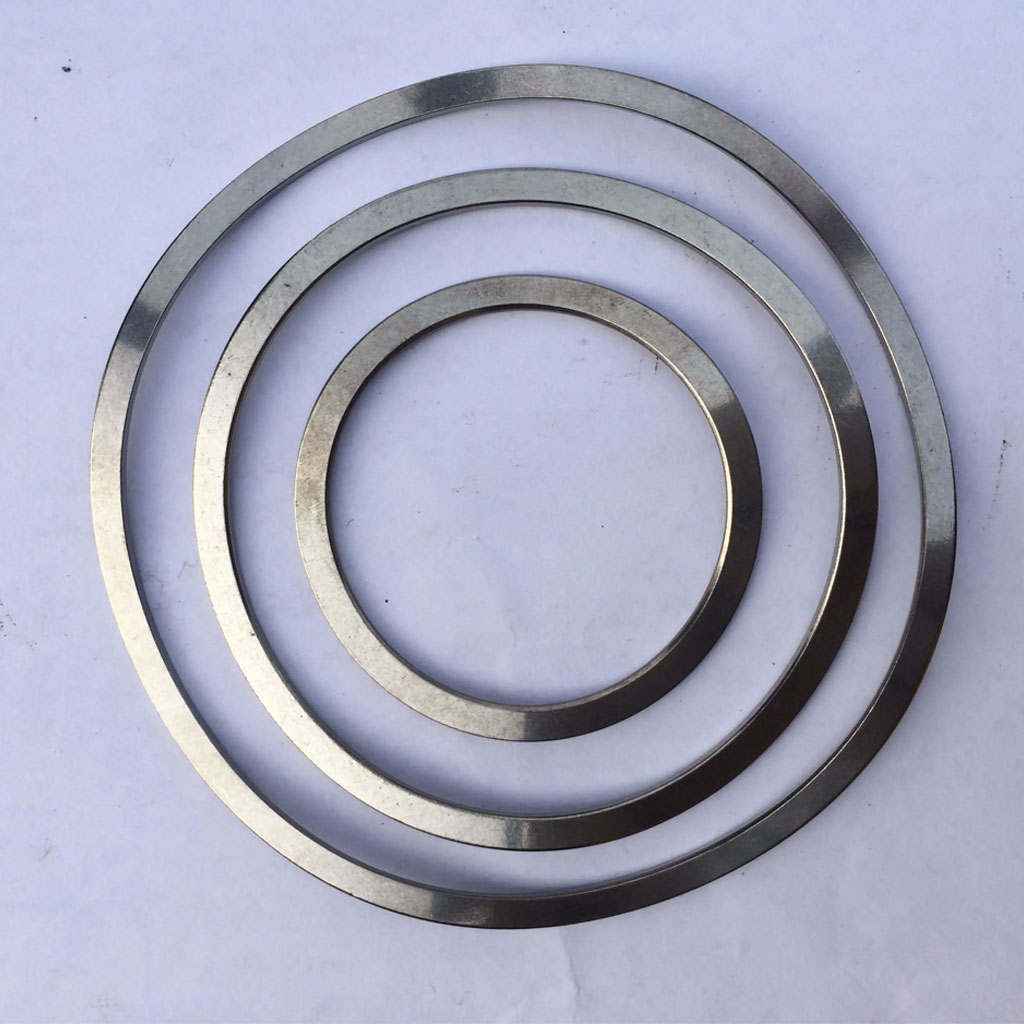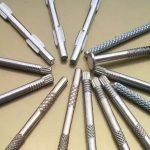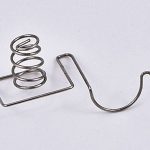
Wave Springs
Wave spring, full name: steel wave spring for motor, also known as wave washer for Y series motor.Be-Cu wave spring is an elastic metal element with several wave-shaped peaks and valleys on a metal sheet ring. It is usually used in equipment with small load and deformation, requiring small spring stiffness and applying axial preload, such as: motors, Small and medium asynchronous motors, compressors, hydraulic presses, automobiles and other equipment.
A wave spring is an elastic element with several peaks and valleys on a thin metal ring. It is usually used in occasions where the load and deformation are not large, and the spring stiffness is required to be small and axial preloading is required. Wave springs are particularly suitable for applications that require weight reduction and applications that are constrained by small installation space. Typical application areas include: aerospace, precision machinery, hydraulic seals, and high-end motors.
Be-Cu wave spring specification range: D9 ~ D240; wave number: 3 ~ 7; heat treatment requires quenching and tempering, 45HRC ~ 52HRC (technical reference value); the material is mainly 65Mn spring steel, and can also be customized according to your needs.
“Be-Cu Spring” strictly follows the national standard JB/T 7590-2005 (replacing JB/T 7590-1994), and the steel wave spring for electric motors produced by the company has the characteristics of high bearing capacity, long fatigue life and small deformation. The perfect choice for industry matching.
The Material Suggest Of Wave Spring
| Materials | Suggest |
|---|---|
| Spring Steel: 65Mn | ≤250°C, it is recommended that you use it in normal environment. |
| In line with the national “YB/T 5058-2005 spring steel, tool steel cold rolled strip” standard | ≤250°C, it is recommended that you use it in normal environment. |
| Stainless steel: SS301, SS302, SS304, SS316 | ≤300°C, it is recommended to use in corrosive environment. |
| Customized according to the material you need. | ≤300°C, it is recommended to use in corrosive environment. |
The Surface Treatment Of Wave Spring
- Oxidation: Heat the wave spring to an appropriate temperature in air or chemicals to form a blue (or black) oxide film on the surface to improve the corrosion resistance and appearance of the wave spring.
- Blackening: The same as the oxidation principle, the wave spring is heated in the air or directly immersed in a concentrated oxidizing solution to produce a very thin oxide film on the surface of the wave spring. Material protection technology.
Treat according to your desired finish… The surface of the wave spring should be smooth, rust-free, burr-free, crack-free and uniform in oxide.
The Specification Table Of Steel Wave Spring For Motor
| Specification | Outer diameter D/mm tolerance ±1.20 | Inner diameter d/mm tolerance ±1.20 | Free height H/mm tolerance ±0.80 | ThicknessS /mm | wave number n | Test height h/mm tolerance ±0.02 | Class M Fmin/N | Class M Fmax/N |
| D9 | 8.5 | 6.4 | 1.6 | 0.2 | 3 | – | – | – |
| D13 | 12.8 | 11.2 | 1.0 | 0.2 | 3 | – | – | – |
| D16 | 15.4 | 11.7 | 2.0 | 0.3 | 3 | 1.0 | 50 | 110 |
| D19 | 18.6 | 14.7 | 2.7 | 0.3 | 3 | 1.0 | 60 | 120 |
| D22 | 21.4 | 15.3 | 3.0 | 0.3 | 3 | 1.2 | 60 | 160 |
| D26 | 25.0 | 18.7 | 4.0 | 0.3 | 3 | 1.2 | 80 | 180 |
| D28 | 27.2 | 20.8 | 4.1 | 0.3 | 3 | 1.2 | 80 | 200 |
| D30 | 29.0 | 22.6 | 3.1 | 0.5 | 3 | 1.2 | 90 | 230 |
| D32 | 31.4 | 26.6 | 4.0 | 0.5 | 3 | 1.2 | 110 | 250 |
| D35 | 34.0 | 27.8 | 4.3 | 0.5 | 3 | 1.5 | 140 | 280 |
| D40 | 38.6 | 32.8 | 3.2 | 0.5 | 4 | 1.5 | 160 | 300 |
| D42 | 40.6 | 34.1 | 3.3 | 0.5 | 4 | 1.5 | 180 | 320 |
| D47 | 45.5 | 38.4 | 4.0 | 0.5 | 4 | 1.5 | 200 | 340 |
| D52 | 50.5 | 41.0 | 3.2 | 0.5 | 5 | 2.0 | 210 | 350 |
| D62 | 60.2 | 50.2 | 3.9 | 0.5 | 5 | 2.0 | 260 | 400 |
| D72 | 69.1 | 59.1 | 5.5 | 0.5 | 5 | 2.0 | 310 | 470 |
| D80 | 78.0 | 70.0 | 3.9 | 0.6 | 6 | 2.0 | 360 | 520 |
| D85 | 83.1 | 73.1 | 4.0 | 0.6 | 6 | 2.0 | 390 | 550 |
| D90 | 87.6 | 78.1 | 4.5 | 0.6 | 6 | 2.0 | 420 | 580 |
| D100 | 97.0 | 87.5 | 5.6 | 0.6 | 6 | 2.0 | 440 | 620 |
| D110 | 107.3 | 97.6 | 4.6 | 0.6 | 7 | 2.0 | 470 | 650 |
| D120 | 116.4 | 107.0 | 5.8 | 0.6 | 7 | 2.0 | 480 | 660 |
| D125 | 120.8 | 111.6 | 5.9 | 0.6 | 7 | 2.0 | 480 | 660 |
| D130 | 128.5 | 109.5 | 4.8 | 0.8 | 6 | 3.0 | 490 | 670 |
| D140 | 138.5 | 119.8 | 4.6 | 0.9 | 6 | 3.0 | 490 | 670 |
| D150 | 148.8 | 125.4 | 4.6 | 0.9 | 6 | 3.0 | 500 | 700 |
| D160 | 159.1 | 137.1 | 4.5 | 1.0 | 6 | 3.0 | 520 | 720 |
| D170 | 169.0 | 142.0 | 4.3 | 1.0 | 6 | 3.0 | 530 | 750 |
| D180 | 179.1 | 145.1 | 4.8 | 1.0 | 6 | 3.0 | 590 | 850 |
| D190 | 187.5 | 154.5 | 5.0 | 1.2 | 6 | 4.0 | 770 | 1030 |
| D200 | 197.5 | 166.5 | 5.5 | 1.2 | 6 | 4.0 | 850 | 1110 |
| D215 | 212.0 | 182.0 | 7.0 | 1.4 | 6 | 4.0 | 1360 | 1660 |
| D240 | 237.0 | 204.0 | 7.5 | 1.4 | 6 | 4.0 | 1410 | 1730 |
The Characteristics Of Wave Springs
- The stiffness range is large, the buffering and vibration absorption ability is strong, and the material deformation energy per unit volume is large.
- It has the characteristics of changing stiffness. The stiffness can be adjusted by changing different combinations of peak height, width and thickness. The stiffness can also be adjusted by the number of combined pieces.
- Compared with the disc spring, it has the advantages of high strength, good flexibility and strong impact resistance.
- The structure and size are compact, and under the same theoretical parameters, the required installation space is small
The Classification Of Wave Springs
Wave springs are further divided into WS series wave springs and WSS series wave springs.
- WS series wave spring: WS series is a continuous winding wave crest staggered corrugated spring. The characteristics of this series of springs are that they can provide ideal elastic force in a small installation space, saving 50% of the space compared to ordinary coil springs.
- WSS series wave spring: WSS series is a wave crest staggered wave spring with a flat ring. In addition to the advantages of the WS type wave spring, the two ends of the spring have flat rings, which is equivalent to adding two washers. Therefore, the elastic force of the spring is more uniform during use, and it is especially suitable for the environment where the two end faces of the installation space have holes, and the WS-type wave crest is easy to sink into the holes and cannot be used.
According to the processing technology, it is divided into: stamping wave spring and winding wave spring



